Catholic Customs
 |
 |
 |
 |
 |
 |
 |
Lenten Practices & Customs - 2
How Lent Permeated Medieval Society
In the Middle Ages, Lent was always taken very seriously; all the people, great and small, turned their thoughts toward the Passion of Christ and assumed an attitude of mourning.
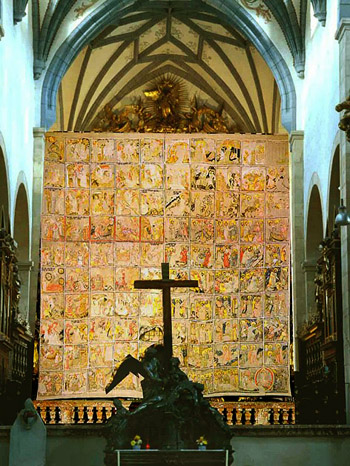 All sorts of festivities such as dancing, festivals, bright decorations and joyous songs were set aside in public and at home. The Church reinforced this spirit by silencing the organ, forbidding flowers to adorn the altar, and banning weddings and similar celebrations.
All sorts of festivities such as dancing, festivals, bright decorations and joyous songs were set aside in public and at home. The Church reinforced this spirit by silencing the organ, forbidding flowers to adorn the altar, and banning weddings and similar celebrations.
In many European countries, it was customary for churches to put up a Lenten cloth called the Velum Quadrigesimale, or Lenten Veil, a large curtain adorned with images of crosses and other penitential symbols. It separated the congregation from the high altar to remind the people of the need to approach the divine mysteries with a spirit of penance.
It was a visible sign for the sinner who had separated himself from God to appease the Divine Justice with penance and fasting so that he might truly merit the sight of the Divine Majesty. (1)
The Veil was parted in the middle to allow the people to view the main parts of the Mass, but otherwise it remained hanging until Holy Saturday. In some places, this cloth would be removed on Wednesday of Holy Week when the Gospel line was read, "And the curtain of the Temple was torn in the middle," thus making way symbolically for the glories of the Resurrection. (2)
The spirit of penance was emphasized by the exterior dress and way of being of Catholics. The monarchs and nobles wore black and conducted themselves with the somberness and seriousness that was characteristic of a mourning period. The peasants, following the example of their sovereign lords, put away their ribbons and adornments and wore their darkest and simplest outfits. All socializing and merry-making - including dancing, music, entertainment and sometimes even house visits - was put aside, giving a contemplative spirit to every castle and village.
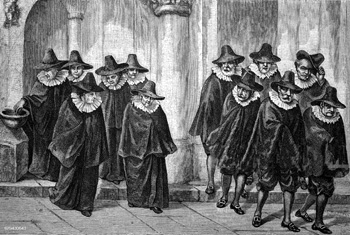 Indeed, all throughout Europe kings and nobles issued mandates prohibiting public amusements and entertainments (especially theatre and secular music) during this holy time. Law courts were even suspended for the whole 40 days. Hunting and war were also forbidden in many countries and regions to honor the sacred season dedicated to the Passion of Our Lord Jesus Crucified.
Indeed, all throughout Europe kings and nobles issued mandates prohibiting public amusements and entertainments (especially theatre and secular music) during this holy time. Law courts were even suspended for the whole 40 days. Hunting and war were also forbidden in many countries and regions to honor the sacred season dedicated to the Passion of Our Lord Jesus Crucified.
The cessation of warfare during Lent and other holy days was known as "The Truce of God." This practice originated in Normandy in the 11th century and soon extended to the whole Church by Pope Gregory IX. (3)
Marriages were also forbidden by canon law during Lent, and many Catholics of old practiced continence in their marriages during this holy season so that they might strengthen the spirit and subdue the flesh.
The Great Fast
The Lenten fast imparted a great unity to all members of society. As early as 379, St. Basil the Great noted:
"There is no island, no continent, no city or nation, no distant corner of the globe, where the proclamation of Lenten fast is not listened to. Armies on the march and travelers on the road, sailors as well as merchants, all alike hear the announcement and receive it with joy. Let no man then separate himself from the number of fasters, in which every race of mankind, every period of life, every class of society is included." (4)
The medieval Lenten fast was quite strict. The rules of the early Church prescribed that only one meal could be eaten every day and that this meal had to be eaten after sunset which marked the end of Vespers. This meal mainly consisted of bread, vegetables and fruit because all fish, meat, eggs and "white meats" (dairy products) were forbidden during Lent. All animal products were avoided because they were seen as symbolic of the carnal pleasures that were given up during Lent to honor Our Lord who suffered immensely for sins of the flesh.
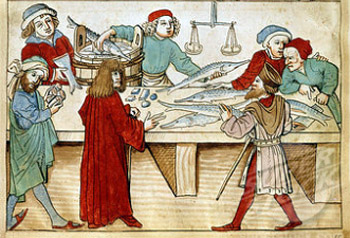 Fish was permitted in the Western Church very early on, but the Eastern Church continued to forbid its consumption. By the end of the Middle Ages, the Church had mitigated the fast to provide for man's weaker constitution. The Vespers were recited earlier in the day so that the faithful could consume their meal sooner in the day at None (3 p.m.).
Fish was permitted in the Western Church very early on, but the Eastern Church continued to forbid its consumption. By the end of the Middle Ages, the Church had mitigated the fast to provide for man's weaker constitution. The Vespers were recited earlier in the day so that the faithful could consume their meal sooner in the day at None (3 p.m.).
Later, even this proved too difficult for many, so permission was given to eat the meal at noon. By the 1400s, some countries permitted milk products to be eaten as well. Only in the 1800s was the rule lessoned to include a piece of bread in the morning, a meal at midday and a small evening collation after dark. These rules applied to clergy and laity alike.
Fasting was the central act of Lent that characterized the spirit and way of being of the people and purified both the body and the soul. In Catholic Europe of old Dom Guéranger observes that the influence of this 40 Days penance was great on society as well as on individuals: "It renewed man’s energies, gave him fresh vigor in battling his animal instincts and, by the restraint it put upon sensuality, ennobled the soul." (5)
Lenten foods
Late in the evening on Shrove Tuesday, women all over Europe washed and scoured their pots and pans to remove all residue of fat, grease or meat. Carnival was over; now all the forbidden foodstuff was stored away out of sight.
This loss of staple items did not prevent creative housewives from developing unique Lenten dishes. Almond milk was used in wealthier homes as a replacement for milk during Lent.
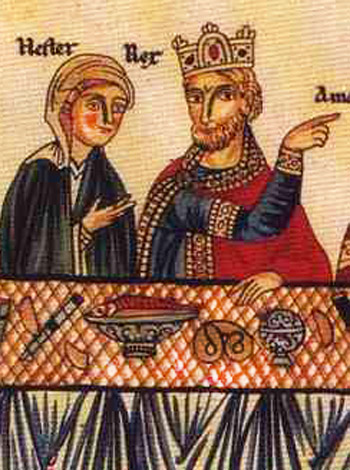
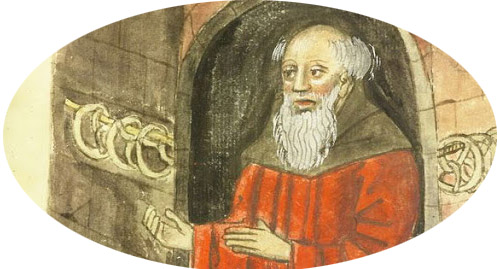 Pretzels were invented by a monk in the 600s as a Lenten bread containing no dairy or eggs and were eaten exclusively during Lent. Medieval man saw them as a perfect accompaniment to the meager Lenten meals because they were shaped like hands in prayer, a reminder of the need for prayer and contrition to accompany the fasting. The ancient position for prayer was to have both arms crossed across the chest, and the Latin word for pretzel, bracellae, means "little arms" referring to this prayer posture.
Pretzels were invented by a monk in the 600s as a Lenten bread containing no dairy or eggs and were eaten exclusively during Lent. Medieval man saw them as a perfect accompaniment to the meager Lenten meals because they were shaped like hands in prayer, a reminder of the need for prayer and contrition to accompany the fasting. The ancient position for prayer was to have both arms crossed across the chest, and the Latin word for pretzel, bracellae, means "little arms" referring to this prayer posture.
The Pretzel is laden with Catholic symbolism. Its three holes represent the Holy Trinity. The rope-like shape was seen by many to be symbolic of the ropes that bound Our Lord's sacred hands during the Passion. Pretzels were given in great quantities to the poor during Lent and were sold in every bakery. In Germany, a man known as the Brezelmann walked through the village selling his pretzels.
In her wisdom, the Church establishes her feasts in accordance with the natural year. Lent occurs at a time when agricultural work is limited and the larder is depleted of the winter store. But fish, a staple of the Lenten diet, is plentiful. In fact the fishing season begins at this time in Northern Europe. The poorer Europeans ate salt herring, while in the manor houses and castles fresh fish was served as Lenten fare.
One beautiful legend shows how God in a wonderful way provided for the nuns in St. Leonard's Convent in Georgia: "Near the church in question there is a great lake at the foot of a mountain, and in this lake are found no fish, great or small, throughout the year till Lent come. On the first day of Lent they find in it the finest fish in the world, and great store too thereof; and these continue to be found till Easter Eve. After that they are found no more till Lent come round again; and so 'tis every year. 'Tis really a passing great miracle!" (6)
In addition to fish, medieval cooks made simple dishes using winter vegetables. The first wild greens of the year, hearty soups made of winter legumes, simple breads and porridges were the common fare. Sweeteners were used sparingly and biscuits and cakes were removed from the menu until Easter.
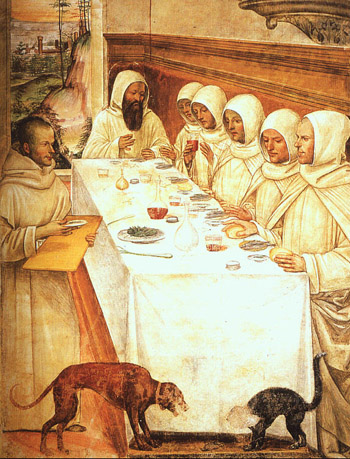 Many peoples had strict fasts that limited the Lenten diet to a few dishes. The Romanian fast consisted merely of corn and beans. The Bulgarians kept Lent in full mourning eating only black food (black beans, black bread, prunes and black olives) to signify their mourning the death of Christ. The Poles mainly ate Żur (a fermented rye soup) that was poured over grains or potatoes. Germans traditionally ate pea soup or pretzel soup – an onion soup served over pretzels. (7)
Many peoples had strict fasts that limited the Lenten diet to a few dishes. The Romanian fast consisted merely of corn and beans. The Bulgarians kept Lent in full mourning eating only black food (black beans, black bread, prunes and black olives) to signify their mourning the death of Christ. The Poles mainly ate Żur (a fermented rye soup) that was poured over grains or potatoes. Germans traditionally ate pea soup or pretzel soup – an onion soup served over pretzels. (7)
The Irish had porridge and a midday meal of potatoes seasoned with fish or onions. Even the children were expected to take part in the fast. Children over age seven were given no milk, while younger children received milk only sparingly. Irish folklore dictates that even the babe was "allowed to cry three times before he got his milk on fast days."
These customs serve to demonstrate how integral the Liturgy was in the lives of the Catholics of old. The Church's year impacted every aspect of their lives, even their clothing and diet. How wondrous was that society that was penetrated to its very depths with the spirit of Our Holy Mother the Church!
Continued
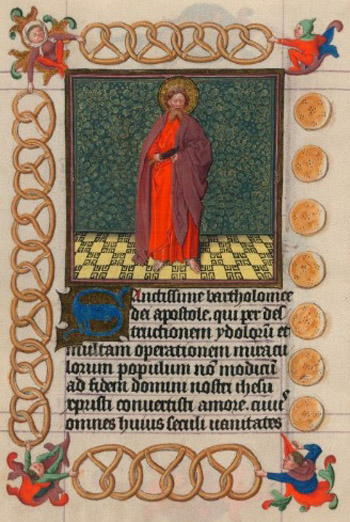

Posted March 12, 2021

Lenten Veil of the Cathedral of Gurk in Austria (1458)
In many European countries, it was customary for churches to put up a Lenten cloth called the Velum Quadrigesimale, or Lenten Veil, a large curtain adorned with images of crosses and other penitential symbols. It separated the congregation from the high altar to remind the people of the need to approach the divine mysteries with a spirit of penance.
It was a visible sign for the sinner who had separated himself from God to appease the Divine Justice with penance and fasting so that he might truly merit the sight of the Divine Majesty. (1)
The Veil was parted in the middle to allow the people to view the main parts of the Mass, but otherwise it remained hanging until Holy Saturday. In some places, this cloth would be removed on Wednesday of Holy Week when the Gospel line was read, "And the curtain of the Temple was torn in the middle," thus making way symbolically for the glories of the Resurrection. (2)
The spirit of penance was emphasized by the exterior dress and way of being of Catholics. The monarchs and nobles wore black and conducted themselves with the somberness and seriousness that was characteristic of a mourning period. The peasants, following the example of their sovereign lords, put away their ribbons and adornments and wore their darkest and simplest outfits. All socializing and merry-making - including dancing, music, entertainment and sometimes even house visits - was put aside, giving a contemplative spirit to every castle and village.

Lenten Ember cloaks worn in Munich, Bavaria, Germany, c. 1680
The cessation of warfare during Lent and other holy days was known as "The Truce of God." This practice originated in Normandy in the 11th century and soon extended to the whole Church by Pope Gregory IX. (3)
Marriages were also forbidden by canon law during Lent, and many Catholics of old practiced continence in their marriages during this holy season so that they might strengthen the spirit and subdue the flesh.
The Great Fast
The Lenten fast imparted a great unity to all members of society. As early as 379, St. Basil the Great noted:
"There is no island, no continent, no city or nation, no distant corner of the globe, where the proclamation of Lenten fast is not listened to. Armies on the march and travelers on the road, sailors as well as merchants, all alike hear the announcement and receive it with joy. Let no man then separate himself from the number of fasters, in which every race of mankind, every period of life, every class of society is included." (4)
The medieval Lenten fast was quite strict. The rules of the early Church prescribed that only one meal could be eaten every day and that this meal had to be eaten after sunset which marked the end of Vespers. This meal mainly consisted of bread, vegetables and fruit because all fish, meat, eggs and "white meats" (dairy products) were forbidden during Lent. All animal products were avoided because they were seen as symbolic of the carnal pleasures that were given up during Lent to honor Our Lord who suffered immensely for sins of the flesh.

A medieval fish market
Later, even this proved too difficult for many, so permission was given to eat the meal at noon. By the 1400s, some countries permitted milk products to be eaten as well. Only in the 1800s was the rule lessoned to include a piece of bread in the morning, a meal at midday and a small evening collation after dark. These rules applied to clergy and laity alike.
Fasting was the central act of Lent that characterized the spirit and way of being of the people and purified both the body and the soul. In Catholic Europe of old Dom Guéranger observes that the influence of this 40 Days penance was great on society as well as on individuals: "It renewed man’s energies, gave him fresh vigor in battling his animal instincts and, by the restraint it put upon sensuality, ennobled the soul." (5)
Lenten foods
Late in the evening on Shrove Tuesday, women all over Europe washed and scoured their pots and pans to remove all residue of fat, grease or meat. Carnival was over; now all the forbidden foodstuff was stored away out of sight.
This loss of staple items did not prevent creative housewives from developing unique Lenten dishes. Almond milk was used in wealthier homes as a replacement for milk during Lent.

Pretzels served even on royal tables during Lent; below a baker displaying his Lenten wares

The Pretzel is laden with Catholic symbolism. Its three holes represent the Holy Trinity. The rope-like shape was seen by many to be symbolic of the ropes that bound Our Lord's sacred hands during the Passion. Pretzels were given in great quantities to the poor during Lent and were sold in every bakery. In Germany, a man known as the Brezelmann walked through the village selling his pretzels.
In her wisdom, the Church establishes her feasts in accordance with the natural year. Lent occurs at a time when agricultural work is limited and the larder is depleted of the winter store. But fish, a staple of the Lenten diet, is plentiful. In fact the fishing season begins at this time in Northern Europe. The poorer Europeans ate salt herring, while in the manor houses and castles fresh fish was served as Lenten fare.
One beautiful legend shows how God in a wonderful way provided for the nuns in St. Leonard's Convent in Georgia: "Near the church in question there is a great lake at the foot of a mountain, and in this lake are found no fish, great or small, throughout the year till Lent come. On the first day of Lent they find in it the finest fish in the world, and great store too thereof; and these continue to be found till Easter Eve. After that they are found no more till Lent come round again; and so 'tis every year. 'Tis really a passing great miracle!" (6)
In addition to fish, medieval cooks made simple dishes using winter vegetables. The first wild greens of the year, hearty soups made of winter legumes, simple breads and porridges were the common fare. Sweeteners were used sparingly and biscuits and cakes were removed from the menu until Easter.

Lenten fare at a Benedictine table
The Irish had porridge and a midday meal of potatoes seasoned with fish or onions. Even the children were expected to take part in the fast. Children over age seven were given no milk, while younger children received milk only sparingly. Irish folklore dictates that even the babe was "allowed to cry three times before he got his milk on fast days."
These customs serve to demonstrate how integral the Liturgy was in the lives of the Catholics of old. The Church's year impacted every aspect of their lives, even their clothing and diet. How wondrous was that society that was penetrated to its very depths with the spirit of Our Holy Mother the Church!
Continued

The pretzel even became decor
for illuminated manuscripts & painting
- Dom Prosper Guéranger, The Liturgical Year, vol. V(Fitzwilliam, New Hampshire, Loreto Publications, 2013) p. 27.
- Francis X Weiser, The Easter Book (San Diego, California: The Firefly Press, 1996), p. 33.
- https://www.newadvent.org/cathen/15068a.htm
- Francis X Weiser, The Easter Book (San Diego, California: The Firefly Press, 1996), p. 38.
- Dom Prosper Guéranger, The Liturgical Year, vol. V, p. 18.
- http://www.armeniapedia.org/wiki/The_Travels_of_Marco_Polo_1:_Chapter_4
- Elisabeth Luard, European Festival Food (London: Bantam Press, 1990), pp. 142-144.

Posted March 12, 2021
______________________
______________________
 |
 |
 |
 |
 |
 |


